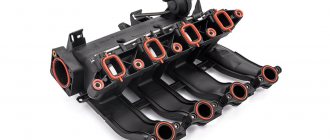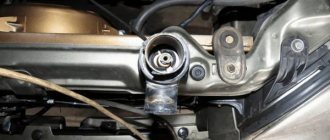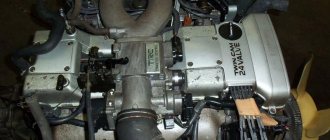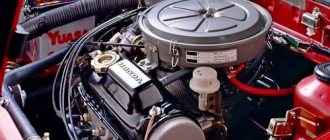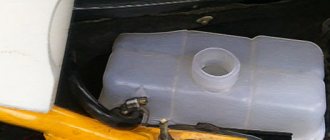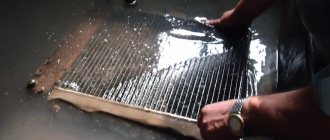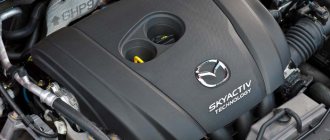When operating a car, we often encounter various types of breakdowns that significantly complicate the use of equipment. One of these malfunctions that causes certain problems is the failure of the stove, which makes it impossible to use the car in the cold season. Let's talk in more detail in what cases the stove fails, how to diagnose this unit and restore its functionality.
Air in the car engine cooling system: signs and methods of eliminating an airlock
The liquid engine cooling system is sealed and consists of a whole complex of different elements that interact with each other.
Also, depending on the coolant temperature, the circulation of the working fluid in a small or large circle directly depends. In this article we will look at the reasons for airing in the engine cooling system, signs that indicate that air has entered the system, as well as the main methods for removing air locks.
Air has entered the engine cooling system: the main signs of airing
For a better understanding, let's start with the general operating principles. While the engine is cold, the liquid circulates only through the cooling jacket (special channels in the cylinder block and cylinder head), without entering the radiator. Circulation is provided by a water pump.
After the coolant temperature reaches a certain value, the thermostat is activated, which opens a large circle (the liquid passes through the radiator). If cooling the coolant when driving in a large circle is not enough, then the engine cooling fan (air cooling) is automatically switched on.
Please note that these malfunctions can occur for various reasons, that is, the engine begins to overheat not only due to air locks, but this possibility should also not be excluded.
As with any closed fluid system, air pockets can cause the system to stop operating normally. In this case, the risk of engine overheating also increases significantly, and the stove stops working normally.
- The main sign of air lock formation is engine overheating. In other words, the temperature rises above normal, the temperature gauge may rise to the red zone. In this case, when checking the coolant level in the expansion tank, no deviations may be detected.
- Also, during the cold season, the driver may notice that practically no warm air enters the cabin, although the engine is normally warmed up. This also indicates that there may be air in the cooling system.
One way or another, the air lock does not allow coolant to circulate normally through the channels of the cooling system. As a result of impaired circulation, certain problems arise. As part of diagnosing the engine cooling system, you should check the coolant level in the expansion tank, and also carefully inspect individual areas of the system.
We also note that air can enter through subtle cracks in the rubber pipes, but there may not be intense leaks through these cracks. Usually such cracks are not immediately visible, but a detailed inspection or injection of air into the system under pressure for testing can reveal problem areas. Also, during the check, you should pay attention to the pump, check the operation of the thermostat and cooling fan.
If everything is normal, then there is a high probability that the stove is not working and the motor is overheating precisely because of air locks. In this case, it is necessary to take measures and “drive” such a plug from the cooling system.
How does the interior heater work?
Why does the engine take a long time to warm up?
The vehicle heating system is structurally integrated with the cooling system - many elements of one are simultaneously included in the other.
This is, first of all, a car radiator and a system of pipes that deliver coolant to all consumers. The ventilation/heating system also includes a fan, air ducts, the stove itself, dampers and a set of deflectors.
The heater radiator should not be confused with its analogue included in the cooling system. The first is located behind the instrument panel in close proximity to the stove, the second is in the front of the car in front of the engine and behind the radiator grille.
During operation, the engine is known to get very hot. The cooling system helps prevent thermal shock; coolant is used as the main heat-removing agent, delivered by a pump to all components of the power unit that require active cooling. The coolant in the engine gets very hot, and to cool it, in turn, the main radiator is used, onto which streams of cool air flow.
On the way to the main radiator, antifreeze fills the tubes and radiator of the heater, which in this case become an analogue of a regular household heating battery. When the fan is turned on, air from the engine compartment passes through the radiator, heating up at the same time, and enters the passenger compartment.
This scheme is considered very effective, and the classic automotive industry is not going to abandon it.
Of course, in summer there is no need to heat the interior, so the car is equipped with a regulator through which you can control the temperature of the air blowing from the deflectors. In winter, as a rule, this regulator is turned on at full power, but if the air does not warm up to 30 degrees, it will not be very comfortable inside the car. In addition, the windows will fog up a lot. In addition to adjusting the temperature of the air flow, the driver can control both the blowing speed and its direction - for each of the above options there is its own regulator. In the cold season, the windshield blower is used almost constantly, and its fogging is prevented not only by the air temperature, but also by the very fact of the presence of air flow, which creates an excessive phenomenon inside the cabin.
Still, the main factor in heating the interior is the efficiency of the heater. If it is low, most likely there is something wrong with the heating system, and the fault should be looked for.
At the same time, when the engine is not warmed up, turning on the heater will lead to the exact opposite effect - air will blow from the deflectors, colder than in the cabin (since the metal radiator is located in the engine compartment and cools down more). As a result, the power unit has to warm up longer, and the heater radiator fogs up, which leads to its premature oxidation.
That is why it is recommended to use the heater only when the engine warms up and the coolant temperature rises to at least 50º.
How to remove an air lock from an engine cooling system
So, let's start with simple cars (old foreign cars, domestic auto industry). On such cars, air is removed from the cooling system as follows:
- All you have to do is drive the car onto the overpass. This must be done in such a way that the front part is slightly raised.
- Next, you need to unscrew a special cap on the radiator, after which the engine can be started.
- After several minutes of operation at idle, the air is bled from the engine cooling system.
However, this method will not help solve the problem on more modern cars. On such vehicles, the cooling system is of a completely closed type, that is, to de-air the air must be “expelled”. To do this, you can go in two ways.
If this method does not help, then the upper pipe that comes from the stove is weakened. You need to be prepared for the fact that the antifreeze itself will begin to leak. Next, the engine starts, and you need to monitor when air bubbles disappear from the leaking coolant. Their disappearance will indicate that the air lock has been successfully removed from the system. Let's look at this method in more detail using the VAZ Kalina model as an example.
Before starting work, you should prepare the keys for dismantling the plastic protective elements. You will also need a screwdriver to loosen and then tighten the clamps.
- So, the first step is to remove the plastic protection. This protection on the specified vehicle model is attached to the body using studs that have rubber seals.
- Next, you need to remove the clamp from the upper or lower pipe. Now you should unscrew the cap of the expansion tank. If the engine is hot, be careful as hot coolant may splash out of the reservoir!
- Then cover the neck of the tank with a clean rag. Next, a suitable rubber tube should be pulled over the neck. After this, you need to supply some air to the tank by blowing into the tube. It is advisable to do this using a compressor.
- After air is supplied to the tank, antifreeze should begin to flow out of the pipe from which the clamp was previously removed. After this, you need to make sure that there are no air bubbles in the leaking coolant, then quickly put the pipe over the fitting, put the clamp in place and tighten it. At this stage, the deaeration process can be considered complete.
- Next, you will need to bring the coolant level to normal (usually “on cold” it is poured 4-5 mm higher than o, since after warming up the internal combustion engine, the liquid will increase in volume and rise to o).
- After this, the engine can be started and warmed up. In some cases, this procedure requires slightly screwing on the expansion tank cap without tightening it. Then you should let the power plant idle, periodically raising the speed. This method will allow you to remove excess air that could have formed when adding liquid.
- If everything is in order, you can tighten the cap more tightly, but do not try to tighten it too much.
Features of the heater on the VAZ-2109
The stove on a VAZ is an ordinary heat exchanger. The heating system is connected to the engine cooling system through a heater valve. When the stove starts, this unit opens and antifreeze enters the radiator of the heating system.
Coolant temperature under normal conditions ranges from 70 to 90 degrees.
As the antifreeze circulates through the radiator pipes, it cools, which leads to the release of heat.
An important component of the heating system on the “nine” is the fan, which operates in one of three modes. This element directs the heated air mass into the nozzles, and the driver regulates the flow distribution using deflectors. In exactly the same way, air enters the car windows.
When you move the heater control knobs, the damper closes completely and warm air does not enter the cabin, or when you set the handle to the extreme right position, all the air flows into the car through the channels.
In the middle position of the regulator, the air passes over the radiator and warms up, while the other part goes past.
Useful tips
To avoid problems with the engine cooling system during operation, as well as to extend the life of the components (pump, thermostat), you cannot use ordinary water instead of antifreeze or antifreeze. It is also not recommended to use distilled water instead of antifreeze. This water should only be used to dilute antifreeze or antifreeze concentrate in the required proportion.
In this case, frequent addition of only distilled water to maintain the level leads to the fact that the density of the solution decreases. This can lead to freezing of coolant in the system in winter. To prevent this from happening, you need to check the density with a hydrometer. If necessary, the density is adjusted by pouring undiluted concentrate.
The main reasons why the stove does not heat well or does not heat at all
Low coolant level. If there is a low level of antifreeze in the cooling system, there will be problems with the circulation of coolant through the cooling system, therefore, the interior heater stove will be either cold or barely warm, since the antifreeze may not reach it at all. Check the coolant level and, if necessary, top up to about.
Faulty thermostat. If the thermostat is stuck in the open position, then at high speeds in cold weather, most likely, the stove will not be able to warm up properly, and as a result, instead of heat, you will get a cold air stream. How to replace a faulty thermostat.
The heater radiator is clogged. Problems with heating the interior are inevitable in case of problems with the radiator of the interior heater stove. Clogged honeycombs prevent normal coolant circulation, as a result of which the stove heats poorly or the stove does not heat at all. Flushing the heater radiator or completely replacing it will help solve the problem.
Faulty pump. If the water pump is faulty, the liquid will not circulate through the system, as a result, not only will the stove not heat, but also engine cooling will be at risk. It happens that the pump jams or its impeller (blades) is destroyed, as a result the pulley rotates, but the coolant does not circulate and the stove does not heat. In some cases, the pump does not work due to a break in the drive belt that drives the water pump pulley. You can learn how to check and replace the pump from this article.
The stove fan is faulty. If the fan malfunctions (jammed bearing, lack of power, etc.), heat is not pumped from the heater radiator, as a result, there will be no warm air flow from the air ducts. Unless while driving, turning on forced air injection, heat will still flow from the air ducts, but as soon as you stop, the stove will stop heating again.
Burnout of the cylinder head gasket. As you know, the engine body consists of a block and a head, and are connected to each other using a special gasket. If this gasket ruptures or burns out, coolant can enter the cylinders. As a result, the stove will most likely stop heating, the coolant level will drop, and, of course, thick white smoke will appear from the exhaust.
As you can see, there are quite a few reasons why the stove does not heat, and each of them requires an appropriate approach. In order to avoid problems with the cooling system and not rack your brains over the question of why the stove is not heating, you should regularly monitor their condition. Monitor the level and quality of coolant in the cooling system, keep the radiator clean and flush it from time to time. Use high-quality antifreeze or antifreeze and monitor the overall performance of the engine.
How can you remove an air lock from the cooling system?
The presence of air in the cooling system is fraught with problems for both the engine and other components of the car. In particular, overheating may occur or the stove will heat poorly. Therefore, it is useful for any motorist to know how to remove an air lock from the cooling system. This procedure is quite trivial, so even a beginner and inexperienced car enthusiast can do it. Due to its importance, we will talk about three methods of removing air. But first, let's talk about how to understand that air jams are occurring and the reasons for their occurrence.
Symptoms of airiness
How can you tell if there is an air lock in the cooling system? When this phenomenon occurs, several typical symptoms occur. Among them:
- Problems with the thermostat . More specifically, if after starting the engine the cooling fan turns on very quickly, then there is a high probability that the thermostat has failed. Another reason for this may be that air has accumulated in the pump nozzle. If the thermostat valve is closed, the antifreeze circulates in a small circle. Another situation is possible when the coolant temperature needle is at “zero” when the engine has already warmed up enough. Here again, two options are possible - a malfunction of the thermostat, or the presence of an air lock in it.
- Antifreeze leak . It can be checked visually by traces of antifreeze on individual elements of the engine or chassis of the car.
- The pump starts to make noise . When it partially fails, extraneous noise appears.
- Problems with the stove . There are many reasons for this malfunction, but one of them is the formation of an air lock in the cooling system.
If you find at least one of the symptoms described above, then you need to diagnose the cooling system. However, before doing this, it will be useful to understand what caused the possible problems.
Malfunctions
Quite often, on VAZ 2106 cars, the engine cooling system fails and requires repair. The main elements that are most subject to wear are the radiator and thermostat. More rarely, the cause of failure is in the pipes. In order to determine that there is a malfunction in this particular system, it is enough to know its characteristic symptoms. The first thing that immediately becomes noticeable is engine overheating. At the same time, in the area of the legs of the passenger and driver, high temperature and hot air flows will be felt. The cause of this malfunction may be either a failure of the thermostat or radiator, or wear of the pipes.
The difference is that when cracks appear in the pipes, a leak of antifreeze or antifreeze will be visually noticeable. It will ooze out, either from cracks or from joints. When you open the hood, there will be visible places on the engine parts that differ significantly from the basic condition, especially in their shine. This effect is obtained due to the constant exposure of the coolant to the same part of the coating.
If the radiator or thermostat is broken, there may not be any drips, but in this case, the antifreeze simply does not enter the radiator, but constantly circulates in the system, not having time to cool, and as a result, boiling away.
The most common cause of antifreeze leakage from a VAZ 2106 engine is wear of the radiator cap valve. It is not possible to determine its failure immediately. If after each trip the antifreeze level decreases, then carry out the following procedure. Immediately after the engine warms up, open the hood and pull out the choke a centimeter so that the crankshaft speed reaches 2000 - 2500 rpm. Keep a close eye on the lid. If, over time, liquid begins to emerge from under it, then this is clearly the reason.
Causes of air locks
Air in the cooling system can be caused by a number of malfunctions. Among them:
- Depressurization of the system . It can occur in a variety of places - on hoses, fittings, pipes, pipes, and so on. Depressurization can be caused by mechanical damage to its individual parts, their natural wear, or a decrease in pressure in the system. If, after you have removed the air lock, air appears in the system again, it means that it is depressurized. Therefore, it is necessary to do diagnostics and visual inspection in order to identify the damaged area.
You need to pour antifreeze in a thin stream.
Each of the reasons described above can damage the components and mechanisms of the car. First of all the engine suffers because its normal cooling is disrupted. It overheats, causing wear to become critical. And this can lead to deformation of its individual parts, failure of sealing elements, and in especially dangerous cases, even to jamming.
Airing also leads to poor stove performance. The reasons for this are similar. Antifreeze does not circulate well and does not tolerate sufficient heat.
Next, let's move directly to the methods by which you can remove the air lock from the cooling system. They differ in the method of execution, as well as complexity.
Reasons for appearance
There are several reasons why air accumulates in the cooling system channels. An air lock is formed due to:
- System leaks. Leaks at the junctions of the pipes lead to the fact that when the liquid flow moves, a vacuum is formed, which sucks air into the system. Gradually the amount of air increases, then it accumulates in one place, forming a plug.
- Loss of tightness in the water pump. If the sealing gasket under the pump is damaged, the unit will suck in air during operation.
- Violation of technology for replacing or adding antifreeze. If you immediately pour a large amount of liquid, the air in the pipes will not escape and the antifreeze will push air bubbles into the system with its own weight. After starting the engine, the air will gather in one place, interrupting the flow.
- Damage to the cylinder head gasket due to overheating. If the resulting breakdown connects the cooling system channel to the atmosphere, the liquid will draw in air from outside. Airing appears if a breakdown connects the channel to the cylinder. In this case, exhaust gases will break into the cooling system, which, in addition to the appearance of an air lock, is accompanied by the bubbling of antifreeze in the expansion tank.
Methods for removing air lock from the cooling system
How to remove an air lock from the cooling system of a VAZ classic
There are three main methods by which you can eliminate an air lock. Let's list them in order. The first method is great for VAZ cars . Its algorithm will be as follows:
- Remove from the engine all protective and other elements that may prevent you from reaching the expansion tank with coolant.
- Disconnect one of the pipes that are responsible for heating the throttle assembly (it doesn’t matter whether it’s direct or reverse).
- Remove the expansion tank cap and cover the neck with a loose cloth.
- Blow inside the tank. This will create a slight excess pressure, which will be enough for excess air to escape through the pipe.
- As soon as antifreeze comes out of the hole for the pipe, immediately put the pipe on it and preferably secure it with a clamp. Otherwise, air will get back into it.
- Close the expansion tank cap and reassemble all previously removed engine protection elements.
The second method is carried out in accordance with the following algorithm:
- Start the engine and let it run for 10.15 minutes, then turn it off.
- Remove the necessary elements in order to get to the expansion tank with coolant.
- Without removing the lid from it, disconnect one of the pipes on the tank. If the system has been aired, then air will begin to escape from it.
- As soon as the antifreeze flows out, immediately replace the pipe and secure it.
Typical cooling system malfunctions
The main malfunctions of the cooling system occur in the event of a violation of the operating conditions of the vehicle. This happens when the system is filled with water, which leads to rust and defects in the system elements. If the coolant temperature sensor of the car's power plant is in the red segment of the scale, this means that the engine begins to overheat, which leads to destructive consequences.
Regardless of the time of year, you should:
After bringing the temperature level of the coolant to the operating value, it is necessary to begin repairing the cooling system of the VAZ 2106, during which you will definitely have to drain the cooler if you have to replace any part of the system. To carry out the work, it is necessary to know the volume of the radiator cooling system if the coolant is to be drained from the radiator element.
To replace the working fluid, we recommend pre-flushing the cooling system, which is carried out in the following order:
- We prepare the necessary tools, spare tanks, and chemicals for flushing the cooling system.
There are videos on the Internet on flushing car cooling systems, which are best watched for clarity.
General recommendations for prevention
The first thing you need to pay attention to is the level of antifreeze in the cooling system . Always monitor it and top up if necessary. Moreover, if you have to add coolant very often, then this is the first call indicating that something is wrong with the system, and additional diagnostics are necessary to identify the cause of the malfunction. Also check for stains from antifreeze leaks. It is better to do this in the inspection hole.
Try to use the antifreeze recommended by your car manufacturer. Make purchases in trusted, licensed stores, minimizing the likelihood of purchasing a counterfeit. The fact is that low-quality coolant can gradually evaporate during repeated heating, and instead of it, an air plug forms in the system. Therefore, do not neglect the manufacturer's requirements.
Instead of a conclusion
Finally, I would like to note that if the described signs of airing in the system appear, it is necessary to carry out diagnostics and check it as quickly as possible. After all, an air lock significantly reduces the efficiency of the cooling system. Because of this, the engine operates under conditions of increased wear, which can lead to premature failure. Therefore, if you detect airing, try to get rid of the plug as quickly as possible. Fortunately, even a novice car enthusiast can do this, since the procedure is simple and does not require the use of additional tools or devices.
Repair
If a malfunction is detected in the engine cooling system, it must be repaired immediately. Otherwise, this may have a detrimental effect on the operation of the motor, and even lead to its jamming.
If the cause of the breakdown is the thermostat, then it most likely needs to be replaced. Or, if you have some experience in repairing such parts, you can purchase a repair kit consisting of a new piston, gaskets, and valves. With a radiator, everything is much more complicated. If cracks appear on its surface, the part must be completely dismantled and welding work must be carried out. But, this method only works on a copper sample. If the aluminum radiator becomes unusable, then only replacing it with a new one will help.
How to remove an air lock from the cooling system?
Make sure the cooling system is sealed. Obviously, air cannot appear in it just like that: this is either a consequence of the fact that when replacing the coolant, the coolant was not poured in accordance with the rules for operating your car, or a sure sign that a hole has appeared in the system through which the coolant flows out, giving way to air .
First, you should check whether the cooling system drain plug is tightened tightly enough. If everything is fine with it, you should carefully inspect the body of the expansion tank and look for cracks in the plastic. The next weak link is the hoses themselves, which unite the entire cooling system: the rubber could dry out and become cracked due to excessively long use or its aggressive conditions.
In the worst case scenario, you may find that air is getting into the system due to a leaky radiator or cylinder head gasket.
When you are sure that the system is airtight and your efforts will not be in vain, get to work.
Raise the front of the car. You can try to park it safely with the front wheels on any hill, or raise the front of the car using a couple of jacks. This must be done so that the air bleed screw located on the radiator becomes the highest point of the cooling system, and the air flows out unhindered there.
Open the interior heater tap. In order to do this, you simply need to put the heater control controls in the extreme position, as if you wanted to warm up the interior. Also set the blowing intensity, if your stove model allows it, to the middle position.
Unscrew the cap of the expansion tank and unscrew the screw to remove air from the cooling system.
Start the engine and let the car idle for a while until the engine warms up and the thermostat and engine speed reach operating values.
Have your assistant drive your car. In order to get rid of unwanted air in the cooling system, it is necessary to periodically press the gas pedal several times and increase engine speed, allowing the coolant to circulate throughout the system. In the meantime, you will add fluid leaking from the system into the expansion tank and monitor whether any air bubbles have disappeared from it.
Also ask your partner to observe the operation of the stove: if, after several presses on the gas pedal at idle speed, it begins to stably perform its functions, that is, supplying hot air to the cabin, consider that your mission is completed.
Reinstall the bleeder screw and let the car idle quietly for a few more minutes.
Pour coolant into the expansion tank until the level reaches the maximum level, and then close the reservoir cap tightly.
Let the car run for another minute. Make sure all caps and plugs are tight and turn off the engine.
Replacing the cable
Other times, car enthusiasts manage to make the heater work by replacing the cable, which is responsible for controlling the heater damper. After replacing what is also called tightening the stretched cable, the stove in the VAZ-2109 begins to work normally, and warm air begins to blow
both in the interior and on the car, which is especially important in bad weather. It is recommended to change or tighten the cable in this order:
- if a visual inspection indicates that the cable cannot be used in the near future due to trivial damage, it certainly needs to be changed and promptly;
- on the contrary, this element has simply stretched, then there is an option to tighten it with an ordinary screwdriver, making a couple of turns clockwise for this purpose;
- The cable is easy to find; it is located on the heater housing, near the accelerator pedal.
The correctly adjusted length of the cable, this fact will be learned from the training video tutorial on the Internet resource, will help to hold the damper in a suitable position, which will then close the resulting gap and the interior will begin to be heated by a warm air flow.
Signs of airing
If it is difficult to start the internal combustion engine, an experienced driver also checks the exhaust. If fuel gets into the engine cylinders, then even in the absence of a full start, smoke should come out of the muffler. It doesn’t matter what color it will be, the main thing is that it should be there, even if it’s barely noticeable.
Thus, if no smoke comes out of the muffler, this is the first sign of airing in the vehicle (fuel system). Fuel is not entering the engine, which means there is air in the system.
There are, of course, cases when smoke comes out, but fuel does not enter the cylinders. The exception is explained by the fact that the smoke that remains in the system comes out. To insure against such a situation (although it occurs rarely, it is possible), it is recommended to keep the starter longer - about a minute without a break. This time is quite enough to fill the exhaust system with smoke.
If air gets into the vehicle, then some peculiarities arise in the operation of the car. For example, problems with startup may appear constantly, for several days, or may not appear for a long time. Of course, this directly depends on the strength of air suction.
Here's what else happens:
- after starting, the engine trembles, shakes, the entire operation of the engine can be assessed as extremely unstable;
- the engine starts well “when cold”, but as soon as it warms up a little, failures begin, right up to a stop;
- the engine does not start at all (this happens in neglected conditions, when air is already sucked in in large quantities).
Why does the VAZ-2109 stove heat poorly and what to do
Car owners of “nines” know the operating features of their car’s heating system.
When everything is fine in summer, in winter the opposite situation occurs, and cold air enters the cabin. And this is already unpleasant, and also harmful to health. In addition, the side and windshields fog up. Problems with the VAZ-2109 stove must be resolved in advance in order to be fully equipped for winter. The stable operation of the heating system in a car can be influenced by a huge number of factors. Therefore, before you begin troubleshooting, you need to generally understand how the system works.
What leads to airiness
There are a number of reasons that affect air getting into the vehicle. But, as a rule, this happens on old and used cars.
So, here are some common reasons why air starts getting into the system.
- The oil seals in the fuel pump are loose or worn out.
- The fuel supply pipes have dried out, and the clamps connecting and fixing them have rotted. Metal hoses rust over time, especially often when the tube enters the fuel tank.
- The fuel filter is not properly sealed.
- A PVC hose is used as a return line (the tube through which fuel returns to the tank). Any violation of the tightness of this important highway leads to a similar situation.
- Problems with the injection pump seal (high pressure pump) in the area of the drive shaft.
- Poor fuel pump cover seal.
Most of the reasons are related to seals. Therefore, it is extremely important to check them regularly and replace old and dry ones.
Separately, I would like to focus attention on the injection pump. This pump itself is very complex in terms of design, and in addition to weak seals, it has many other possible places for air leaks. Only specialists can carry out qualified diagnostics of the injection pump, so if in doubt, it is advisable to show the pump to them immediately.
injection pump
The natural causes of vehicle airing were given above. They arise due to aging, and this process cannot be stopped, but it can be prolonged. There are also reasons that led to air leaks due to improper repair operations.
For example, the fuel filter was replaced. Experts say that often a new filter is either installed incorrectly or a low-quality version is installed. The latter actually happens all the time these days. It seems like I bought the part in a store, but it turns out it’s defective, a fake. As for replacement, it must be carried out competently and carefully. Often amateurs install the element being repaired normally, but through negligence spoil the fuel connections, hooking them with a screwdriver or something else. As a result, a hole appears, from where air comes.
You should know that airing of a vehicle occurs when any main line or branch is damaged, be it a return line or a supply line.
It also happens that air gets into the system due to a bad road. You are rushing, say, at high speed, and one wheel falls into a hole. The flight is normal, the movement continues, you are an ace. But during this maneuver, the fuel in the tank goes completely in one direction, and the pump grabs air instead of fuel. This happens on cars with flat tanks.
